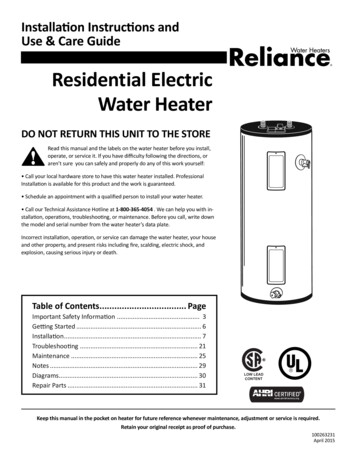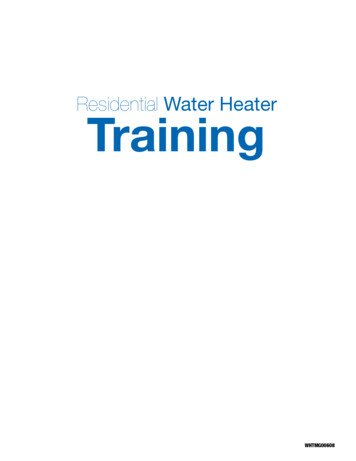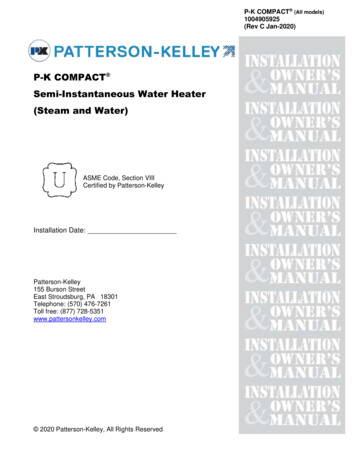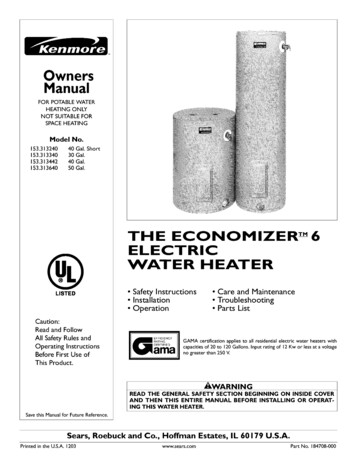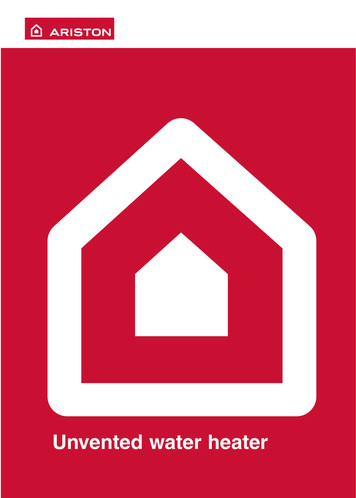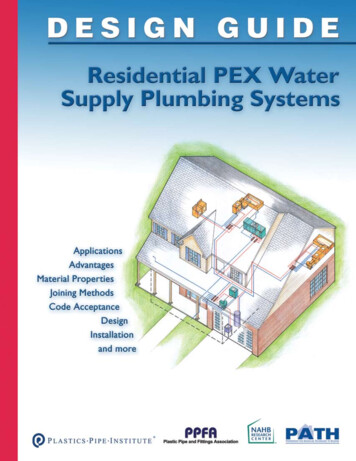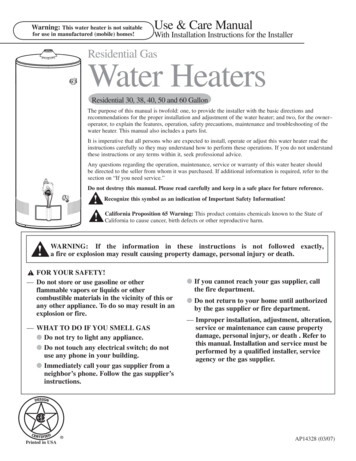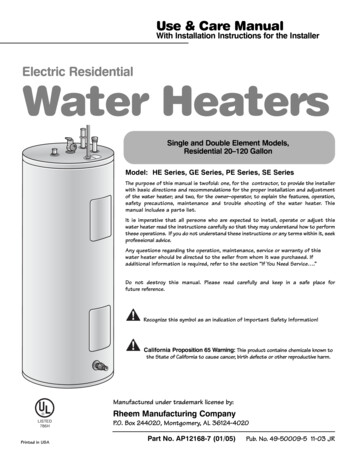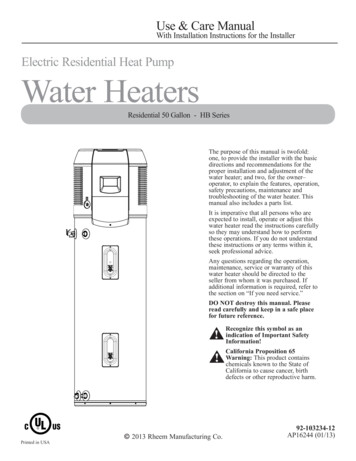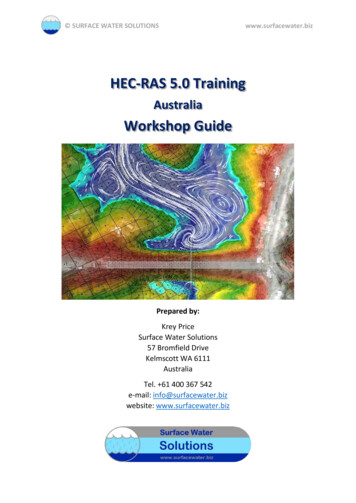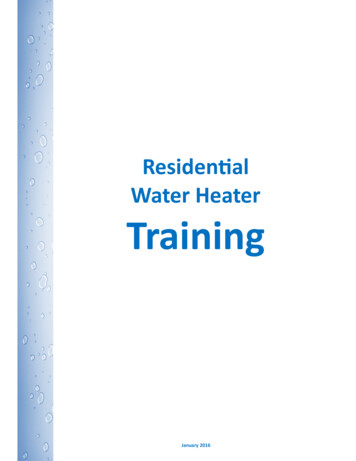
Transcription
ResidentialWater HeaterTrainingJanuary 2016
IntroductionThe purpose of this manual is to provide training for employees in the basic concepts of residential electric and gas storagetype water heaters.This manual is organized into the following sections:Electric Water Heater PartsPhotographs, illustrations and a brief description of the parts of an electric water heater.Electric Water Heater OperationHow standard electric water heaters transfer heat into water.Gas Water Heater PartsPhotographs, illustrations and a brief description of the parts of a gas water heater.Gas Water Heater OperationHow standard gas and FVIR water heaters transfer heat into water.ApplicationsTypes of water heaters available and their application.WaterCommon potable water sources and how water impurities affect a water heater.SpecificationsFormulas and information for determining the efficiency of a water heater.SafetyCorrosion, thermal expansion and excessive water temperatures.MaintenanceBasic water heater maintenance procedures.Sizing and PerformanceDefinition of hot water, how to determine hot water demand, water heater capacity and efficiency.Testing and StandardsQuality, safety and efficiency standards for water heaters.DefinitionsCommon terms used throughout this manual.Upon completion of this manual, the reader should have a basic understanding of electric and gas water heateroperations, applications, performance, service issues, safety issues and industry standards.This manual does not assume any particular skill level or experience of the reader. AOS does notaccept any liability for incomplete, outdated or incorrect information provided in this manual. Improper servicing of waterheaters can result in property damage, bodily injury or death. Do not attempt to service any water heater if you have anydoubt about your ability to do so. Consult a qualified professional.2Copyright by A.O.Smith Jan. 2016. All rights reserved.
IndexSection IndexIntroduction . 2Standard Electric Water Heater Illustration. 4Electric Water Heater Parts . 5Energy Smart/Energy Saver Water Heater Illustration 7Energy Smart/Energy Saver Heater Parts . 8Electric Water Heater Operation . 9Standard Gas Water Heater Illustration . 12FVIR Water Heater Illustration . 13FVIR Water Heater Series 100 Illustration . 14Gas Water Heater Parts . 15Gas Water Heater Operation . 18Gas and Electric Water Heater Parts . 24Applications . 26Water . 30Safety . 32Sizing and Performance . 36Specifications . 39Testing and Standards. 40Definitions . 42Topic Index. . 45Photo Index:Standard Electric Water Heater . 4Electric Water Heater Jacket. 5Electric Water Heater Insulation . 5Electric Water Heater Tank . 5Electric Water Heater Element . 5Electric Water Heater Control Circuit . 6Energy Smart/Energy Saver Electric Water Heater . 7Standard Gas Water Heater . 12FVIR Water Heater . 13FVIR Water Heater Series 100 . 14Gas Water Heater Jacket . 15Gas Water Heater Insulation . 15Gas Water Heater Tank and Flue . 15Gas Water Heater Burner . 16Gas Water Heater Venting . 16Gas & Electric Water Heater Dip Tube . 25Gas & Electric Water Anode Rod . 25Gas & Electric Water Heater T&P Valve . 25Gas & Electric Water Heater Drain Valve . 25Heat Traps . 24Flames on Flame Trap . 20,22FVIR Thermal Cutoff Switch . 21,23FVIR Lint Shedding . 22Lowboy Water Heater . 26Table Top Water Heater . 26Tiny Titan Water Heater . 27Mobile Home Water Heater . 27Copyright by A.O.Smith Jan. 2016 All rights reserved.Direct Vent Water Heater . 28Power Vent Water Heater . 29Power Direct Vent Water Heater . 29Suspended Solids in Water . 30Milky Water . 30Scale on Elements. 31Depleted Anode Rod . 32Electric Reset Button . 34FVIR Lint Filter . 36Illustration Index:How an Electric Water Heater Works . 9Standard Gas Valve Front View . 21Standard Gas Valve Side View . 21How a Gas Water Heater Works . 21FVIR Gas Valve . 21,23Honeywell Gas Valve Front View . 23Honeywell Gas Valve Side View . 23Heat Traps . 24Atmospheric Venting . 27Venting Types . 28Direct Venting . 28Power Venting . 29Power Direct Venting . 29Lime Deposit Chart . 31Galvanic Corrosion . 32Collapsed Flue. 33Expansion Tanks . 33Common Water Temperatures by Application . 35Scald Warning Label . 35T&P Valve Operation . 36Residential Water Heater Sizing Guide . 38Standby Heat Loss . 39Energy Guide Label . 41Formula Index:Gas Recovery Capacity . 38Electric Recovery Capacity . 38Percentage of Hot Water Required . 38Water Use Per Activity . 383
Standard Electric Water HeaterThis section provides an overview of electric water heaters. The first part of this section has illustrations, photographs and a briefdescription of each part. The second part of this section describes the operation of standard electric water heaters. When this sectionis completed, the reader should have a basic understanding of how an electric water heater transfers heat into water.Hot Water OutletCold Water InletJunction BoxCFC Free Foam InsulationT&P ValveReset ButtonThermostatOuter JacketDip TubeAnode RodGlass Lined TankHeating ElementDrain Valve4Copyright by A.O.Smith Jan. 2016. All rights reserved.
Electric Water Heater PartsGlass Lined Tank – A water heater tank is constructed ofthree pieces of steel: a top head, a bottom head and ashell. These three pieces are welded together to form atank that will withstand a working pressure of 150pounds per square inch. The interior of the tank is coatedwith glass lining, baked on at about 1600 F, which willnot break or crack, unless it receives a blow severeenough to dent the steel tank. This coating helps protectthe tank from the corrosive effects of hot water.Outer Jacket - The outer jacket of an electric water heaterconsists of three pieces: the jacket top, jacket skirt and jacketbottom. The jacket provides a space for insulation around thetank, preventing the consumer from coming into contact withhot surfaces and to reduce energy loss. Connections extendfrom the tank through the outer jacket to provide plumbingconnections for the cold water inlet and the hot water outlet.Incoloy ElementPolyesterFoam DamPlated Copper ElementInsulation - Between the tank and the outer jacket is a layerof insulation. Three materials are used as insulation in waterheaters: CFC free polyurethane foam, fiberglass and polyester. Polyurethane foam is the more efficient of these materials and is injected through a port in the outer jacket in liquidform. This liquid expands quickly filling in the space betweenthe tank and jacket and then dries. Polyester or fiber-glass isused around all openings and controls to ensure that the polyurethane foam does not cover these devices.Copyright by A.O.Smith Jan. 2016 All rights reserved.Element - The element consists of an inner wire surrounded byfiller material enclosed in a sheath of copper or stainless steel.The thermostat allows electrical current to flow through theinner wire and from the wire’s resistance it also creates heatwhich is transferred through the filler material to the outersheath and is then absorbed by the water. Elements may beavailable in different wattages and materials to meet specificheating requirements5
Standard Electric Water Heater PartsControl Circuit - The standard single-phase control circuit consists of a high limit control switch with a resetbutton, upper thermostat, lower thermostat, two heating elements and wires. The upper thermostat firstsends electrical energy to the upper element until the water temperature in the upper third of the tank reaches the thermostat setting. Power is then transferred to the lower element until the remaining water reachesthe lower thermostat setting. If the water temperature exceeds 170 F the high limit control switch will tripshutting off power to the elements. Single element water heaters have one element mounted at the bottomof the tank controlled by a single thermostat and high limit switch.TOD Wiring DiagramAPCOM Wiring RedResetButtonUpperThermostat&High tWire colors will vary depending onmanufacturing location6Copyright by A.O.Smith Jan. 2016. All rights reserved.RedUpperThermostat&High LimitControl
Energy Smart/Energy Saver Electric Water HeaterNippleHeat TrapHeat TrapNippleSmart GridAnode RodDipTubeElectronicThermostat (ET)ElementEnergy SmartModule (ESM)T&P ValveThermistor SensorElementCopyright by A.O.Smith Jan. 2016 All rights reserved.Drain Valve7
Energy Smart/Saver Water Heater PartsEnergy Smart II/Energy Saver Electric Operation - The ES electric water heater includes an Energy SmartModule (ESM) user interface which allows homeowners to easily adjust the temperature, operating mode,and view diagnostic information without requiring any tools or removal of water heater components. TheESM is connected to an Electronic Thermostat (ET) above the upper element. Additionally, the Smartgridconnector located at the top of the water heater on the electrical junction box is connected and ready forfuture utility demand response.Fused Disconnector Circuit BreakerL1L2On Junction BoxCoverRed(ESM)BlackBlackRedGreenSmart GridWire HarnessL1L3ElectronicThermostat (ET)T2L4T4ResetButtonElementBlack - 2 wiresYellowBlueTemperature SensorElectronic Thermostat (ET)BlackBlack - 5 wiresBlueElementEnergy Smart Module (ESM)GroundScrew8Electrical ServiceGroundCopyright by A.O.Smith Jan. 2016. All rights reserved.
Electric Water Heater OperationStandard ElectricThe standard residential electric water heater controlcircuit consists of a manual reset high limit switch, anupper thermostat, lower thermostat, two heating elements and wires.When the upper third of the tank is heated to the temperature set on the upper thermostat, power is switchedto the lower heating element. The lower element heatsthe water in the lower 2/3 of the tank until the lowerthermostat is satisfied.Copyright by A.O.Smith Jan. 2016 All rights reserved.When power is initially turned on to the unit, the upperelement is energized and heats the water in the upperthird of the tank.As hot water is drawn from the top of the tank, thedip tube delivers cold water to the bottom of thetank.9
Electric Water Heater OperationWhen installing a new electric water heater or followingdraining the tank for maintenance purposes, the tankshould be completely re-filled and purged of air before applying power to the elements. Energizing a heating element that is not fully submerged in water is referred to as"dry firing," and will cause the element to immed
Outer Jacket - The outer jacket of an electric water heater consists of three pieces: the jacket top, jacket skirt and jacket bottom. The jacket provides a space for insulation around the tank, preventing the consumer from coming into contact with hot surfaces and to reduce energy loss. onnections extend from the tank through the outer jacket to provide plumbing connections for the cold water .
